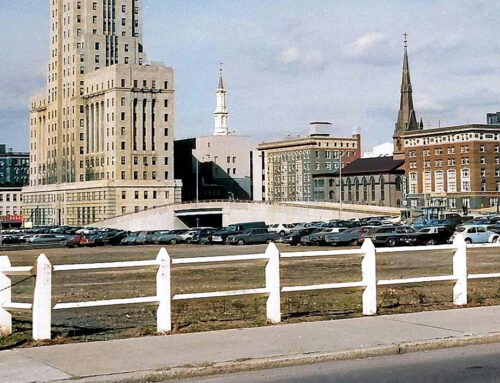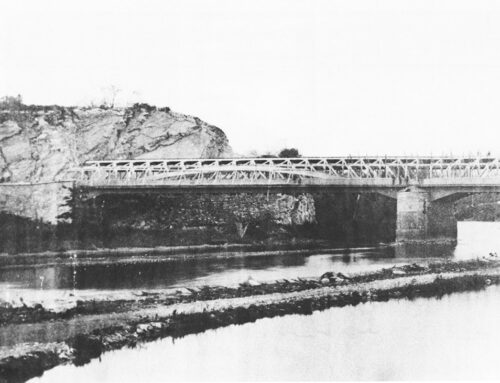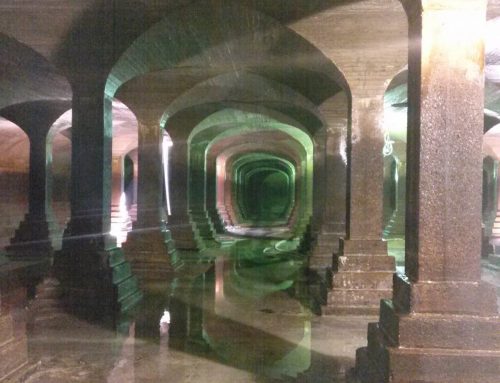One of the most historic spots along Muhlenberg Township’s River Road is the intersection with Leisz’s Bridge Road. Leisz’s Bridge was an important commercial link between Bern and Muhlenberg Townships. In particular, the early dairies in Muhlenberg Township benefited from the ease of access for farmers from Bern. The area of Leisz’s Bridge was an important water center and mill. The first township water works was located slightly up the road near the intersection of Stoudt’s Ferry Bridge and Leisz’s Bridge Roads. Beginning just below the dam at this location, there was an intricate system of water channels and races. The property at 914 Leisz’s Bridge Road was traversed by a water race and contained a millpond. The water then ran under Leisz’s Bridge Road, through the corner property of Adam Leisz, known as 911 Leisz’s Bridge Road, supplying water to the property.
Below: The historic stone structure at 911 Leisz’s Bridge Road was restored to its original splendor by Joan and her late husband Norman Danfelt. The house has four working fireplaces. The original plaster in the house is made of lime, steer hair, and ground shell. All woodwork and doors on the property are original, including the Dutch elbow rim locks with large brass knobs. The cellar was once used by the Leisz family as the office for their grist and sawmill, which was located diagonally across River Road.

Across the road on the riverside of River Road is the historic home known as 3100 River Road, meticulously restored by Wilbur Latshaw. The original structure was a summer cookhouse, smokehouse, and kitchen which served the Leisz house across the street when the properties had been connected as a large plantation tract. The walls of the original cookhouse or smokehouse are incorporated into the structure as it exists today, which has seen a number of additions over the centuries. The house’s stone walls are 68 inches thick at their base. Date stones show the years 1853 and 1875 respectively. A brick addition to the property was reportedly built for a daughter of Adam Leisz, when her brother, also Adam, received the main manor house across the street. The 1875 stone indicates that the house was “rebuilt” in that year by W.K. & E. Rothenberger. The house has seven fireplaces added over the centuries.
Below: 3100 River Road.

Below: Brick addition.

In the 1960’s it was discovered that underground brick waterlines or races had traveled under River Road from 911 Leisz’s Bridge Road to the property at 3100 River Road, before going under the prior road bed of Leisz’s Bridge Road a second time, to serve Leisz’s Mill. At one time all of these properties were under the common ownership of the Leisz Family.
Part of the former roadbed of Leisz’s Bridge Road remain on the property at 3100 River Road, illustrating the access direction to Leisz’s Bridge. Today all that remains of Leisz’s Bridge are the pillars that form an island in the middle of the river designating the crossing point that the bridge once made. Maps of the area in 1907 show that River Road, when it arrived at 3100 River Road, previously turned and ran directly along the river bank, rather than in its current location in front of 3100 River Road.
Leize’s (sometimes spelled Leisz) Bridge spanned the Schuylkill River from “behind the Reading Airport” in Bern Township to the intersection of Leisze’s Bridge Road and River Road in Muhlenberg Township.
Below: Approximate path of Leisz’s Bridge Road.

Leize’s Bridge was built by a private corporation to provide a crossing from Muhlenberg Township to Bern Township and to collect tolls from the persons utilizing the structure. It was actually built in Alsace Township because in 1833 Muhlenberg Township did not exist. The Leize’s Bridge Company was composed of Adam Leize, David Bright, David Gehr, Henry Hahn, John Stauch, Jacob Ebling, Jacob Kline, William Hain, and Phillip Fox.
The bridge was comprised of two spans of unequal length, with a combined total of 336 feet. There was a two-story tollhouse on the Bern Township abutment. A mill was located just south of the east end of the bridge, right along what had previously been the Schuylkill Canal, now River Road.
Below: A view of Leize’s Covered Bridge from the west bank (Bern Township side) with the tollhouse on the left. On the right, in Muhlenberg Township, is Leize Mill.

The Great Flood of 1850 destroyed most of the bridges in Berks County, including this one, but it was rebuilt in approximately thirteen months. In 1932 the bridge was damaged by a small fire, which fortunately was put out before any major damage occurred. In 1949 the state highway department gave Leisz’s a new floor, renewed the frame walls, reinforced the center pier, provided a corrugated tin roof and a fresh coat of white paint. At 12:30 p.m. on Wed., June 18, 1952, a call was made to the Reading Airport fire department for help with a fire of unknown origin. Twenty-five minutes later, the entire bridge – portions on both sides of the mid-river pier – collapsed at the same time. Rapid destruction was attributed to thoroughly dried timbers and high wind blowing from the west. The bridge was never replaced.
Below: Leisz’s Covered Bridge, destroyed by fire, June 18, 1952.







Leave A Comment